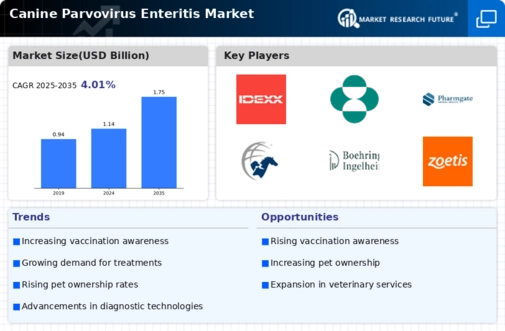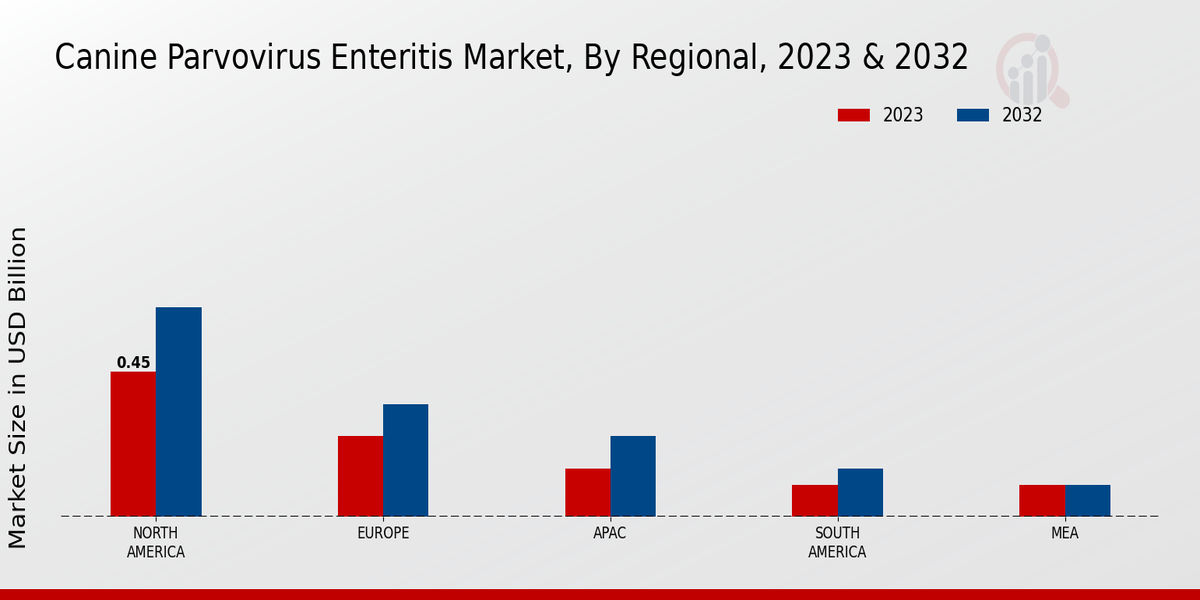Market Growth Projections
The Global Canine Parvovirus Enteritis Market Industry is projected to experience substantial growth over the next decade. With a market value of 1.14 USD Billion in 2024, it is anticipated to reach 1.75 USD Billion by 2035, reflecting a compound annual growth rate (CAGR) of 3.96% from 2025 to 2035. This growth is driven by various factors, including increased awareness of canine health, advancements in veterinary medicine, and regulatory support for vaccination programs. The market's expansion is indicative of the ongoing commitment to improving canine health outcomes and addressing the challenges posed by parvovirus infections.
Growing Awareness Among Pet Owners
The increasing awareness of canine health issues among pet owners serves as a significant driver for the Global Canine Parvovirus Enteritis Market Industry. Educational campaigns by veterinarians and animal welfare organizations have heightened understanding of the risks associated with parvovirus. Pet owners are now more inclined to vaccinate their dogs and seek veterinary care at the first signs of illness. This shift in behavior is likely to result in a more proactive approach to canine health, thereby fostering market growth. As awareness continues to spread, the demand for vaccines and treatment options is expected to rise, further supporting the industry's expansion.
Advancements in Veterinary Medicine
Technological advancements in veterinary medicine significantly influence the Global Canine Parvovirus Enteritis Market Industry. Innovations in diagnostic tools, treatment protocols, and vaccine development enhance the ability to manage and prevent parvovirus infections. For instance, the introduction of rapid diagnostic tests allows for quicker identification of the virus, facilitating timely intervention. Additionally, improved vaccine formulations have shown increased efficacy, leading to higher vaccination rates among dogs. As the market evolves, these advancements are expected to contribute to a projected growth rate of 3.96% CAGR from 2025 to 2035, indicating a robust future for the industry.
Emerging Markets and Pet Ownership Trends
Emerging markets are witnessing a surge in pet ownership, which is poised to drive the Global Canine Parvovirus Enteritis Market Industry. As disposable incomes rise in these regions, more households are adopting pets, leading to increased demand for veterinary services and preventive care. Countries in Asia and Latin America are particularly notable for their growing pet populations. This trend not only raises awareness about canine health but also stimulates the need for effective treatments and vaccines. The expansion into these markets is expected to significantly contribute to the overall growth trajectory of the industry.
Increasing Incidence of Canine Parvovirus
The rising incidence of canine parvovirus enteritis is a primary driver for the Global Canine Parvovirus Enteritis Market Industry. As pet ownership continues to grow globally, the exposure of dogs to this highly contagious virus increases. Reports indicate that the disease can lead to severe gastrointestinal distress, resulting in high mortality rates if left untreated. The market is projected to reach 1.14 USD Billion in 2024, reflecting the urgent need for effective vaccines and treatments. This trend underscores the importance of vaccination programs and veterinary care, which are essential for controlling outbreaks and ensuring the health of canine populations.
Regulatory Support for Vaccination Programs
Regulatory bodies play a crucial role in shaping the Global Canine Parvovirus Enteritis Market Industry through the endorsement of vaccination programs. Governments and veterinary associations advocate for routine vaccinations as a preventive measure against parvovirus outbreaks. This regulatory support not only promotes public health but also encourages pet owners to comply with vaccination schedules. As a result, the market is likely to benefit from increased vaccine uptake, contributing to the projected market value of 1.75 USD Billion by 2035. The alignment of regulatory frameworks with public health initiatives is essential for sustaining growth in the industry.






















